Tsho Rolpa Lake Trek
Tsho Rolpa Lake trek is an offbeat trekking area of Nepal. This trail is popular for its untouched natural beauty and a wide range of mountain vistas.
Tsho Rolpa Lake trek is an offbeat trekking area of Nepal. This trail is popular for its untouched natural beauty and a wide range of mountain vistas.

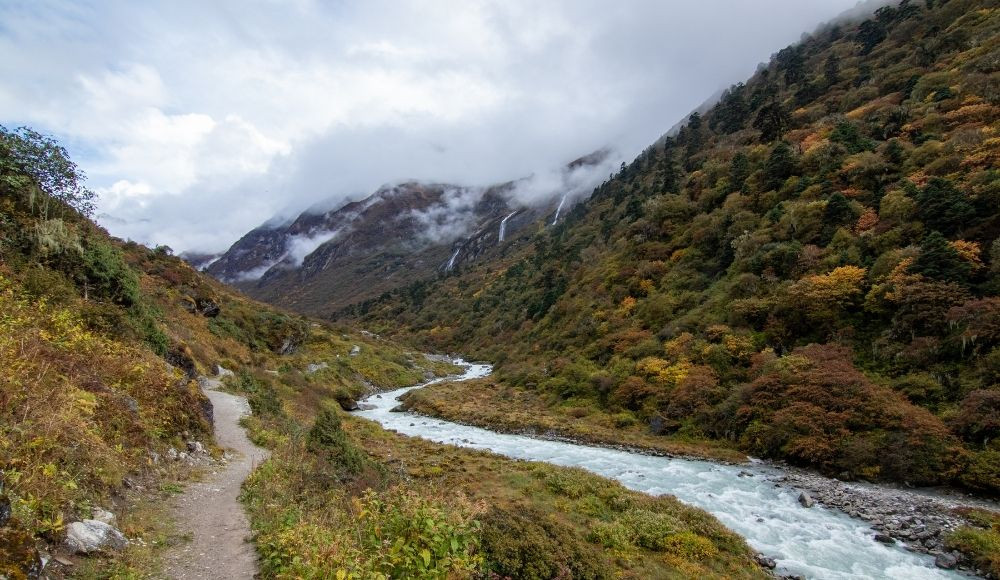
Tsho Rolpa Lake Trek in Nepal is a hidden gem and one of the most underrated and short treks in the country. It offers breathtaking landscapes, rich cultural experiences, and access to the largest glacier lake in Nepal. The trek starts from Kathmandu and takes you through Rolwaling Valley, a secluded and beautiful region in the Himalayas of Nepal.
Situated in the Dolakha district of Nepal, the Tsho Rolpa Lake Trek leads you to the tranquil shores of Tsho Rolpa Lake. Known for its pristine beauty and untouched landscapes, Rolwaling Valley offers an opportunity to connect with nature on a profound level. As you hike through the trail, you will be immersed in a world of towering peaks, meandering rivers, and lush forests, creating an unforgettable backdrop for your trekking adventure.
The highlight of the trek is undoubtedly the mesmerizing Tsho Rolpa Lake itself. Situated at an elevation of 4580 meters, this glacial lake mirrors the surrounding snow-capped peaks. The serenity and tranquility of the lake offer a respite from the outside world, allowing you to immerse yourself in its beauty and find solace in the breathtaking surroundings.
While the Tsho Rolpa Lake Trek offers an unparalleled connection with nature, it is also an opportunity to immerse yourself in the cultural heritage of the local communities. Encounter warm and welcoming villages along the trail, where you can learn about their traditions, visit monasteries, and overall have a holistic experience.
To ensure a successful and safe trek, it is essential to be well-prepared. Adequate physical fitness, proper equipment, and knowledge of the trail are crucial. Engaging the services of an experienced guide will not only enhance your trekking experience but also provide valuable insights into the region's history, culture, and natural surroundings.
Tsho Rolpa Lake Trek is classified as a moderately challenging trek that typically lasts around 7 days, allowing ample time for acclimatization and enjoyment of the breathtaking surroundings. The journey begins from Kathmandu to Charikot, followed by a scenic route leading to the trek starting point at Chet Chet. Along the way, you will encounter stunning waterfalls, suspension bridges over the rivers, and magnificent views of the surrounding mountains.
The Rolwaling Valley, located in the Gaurishankar Conservation Area, is home to majestic peaks like Gaurishakar (7,134 m) and Melungtse (7,181 m). The valley is isolated and untouched by the outside world, offering a raw and unfiltered experience of the wild.
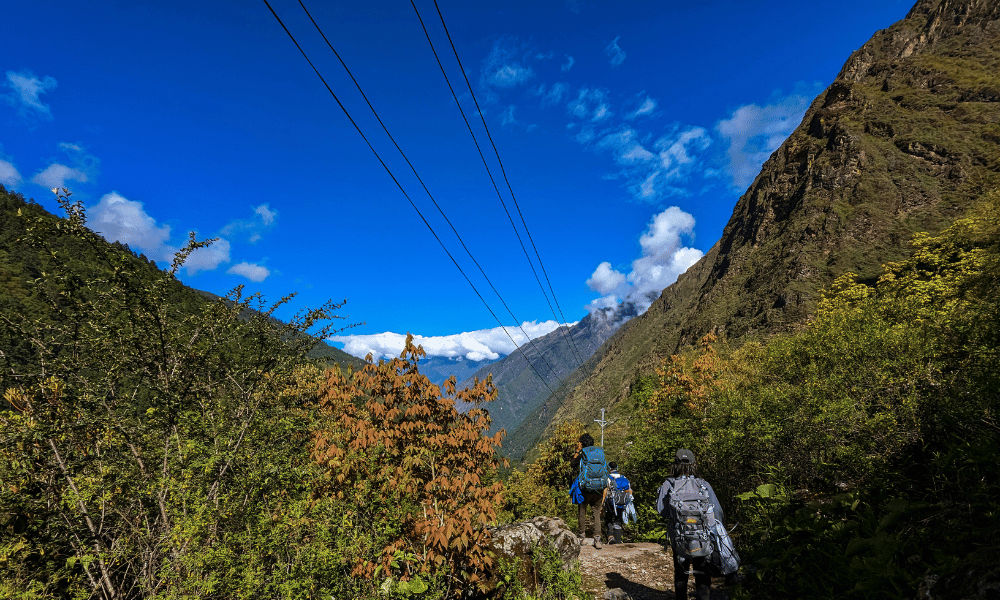
Throughout the trek, you will pass through celestial villages like Simi Gaun, Dongang, Bedding, and Naa Village. These villages offer authentic experiences of village life in the mountains, with traditional homes, fields, and monasteries. The hospitality of the locals and their rich cultural traditions add depth to the trekking experience.
The Tsho Rolpa Lake Trek is relatively easy compared to other treks in Nepal, making it suitable for those with limited time and trekking experience. The trail provides comfortable lodges with basic amenities, allowing trekkers to rest and enjoy vistas along the way. There’s no doubt, this trek leads you through a hidden paradise, offering a perfect blend of cultural experiences, and adventure. It is a trek that will leave you with lasting memories and a new perspective on the hidden treasures of Nepal.
The Tsho Rolpa Lake Trek takes you through the stunning landscapes of the Rolwaling region, offering breathtaking mountain views, serene forests, and traditional villages. Here is a trail description and basic guide to assist you along the journey:
|
Trek Name |
Tsho Rolpa Lake Trek |
|
Location |
Gaurishankar Conservation Area Dolakha District, Nepal |
|
Permits |
|
|
Trek Starting Point |
Chhyot Chhyot (also called Chet Chet)
|
|
Chhyot Chhyot to Simigaun |
|
|
Simigaun to Surmuche |
|
|
Surmuche to Dongang |
|
|
Dongang to Thangding |
|
|
Thangding to Beding |
|
|
Beding to Naa |
|
|
Naa to Tsho Rolpa |
|
Begin your trek from Chetchet, a small village located at an elevation of 1,398 meters.
From here, the trail gradually ascends, passing through forests and offering glimpses of the surrounding hills.
After leaving Chetchet, cross a beautiful suspension bridge and climb steep stairs to reach Simi Gaun.
The trail is well-maintained, and you'll pass through terraced farmlands showcasing seasonal crops.
Enjoy the peaceful ambiance and explore the village, interacting with friendly locals.
Leave Simi Gaun and continue your trek towards Dongang, following an uphill trail.
The path runs alongside the Rolwaling River, offering scenic views and the soothing sound of flowing water.
Dongang is a charming village situated beside the river, surrounded by lush green forests.
Depart from Dongang and trek towards Beding, encountering mesmerizing landscapes along the way.
Cross bridges over powerful rivers and pass by Rolwaling Sangag Cholig Monastery School.
As you approach Beding, the scenery transitions to open pasturelands with fewer trees.
Beding is a picturesque village nestled under massive hills and alongside a beautiful river.
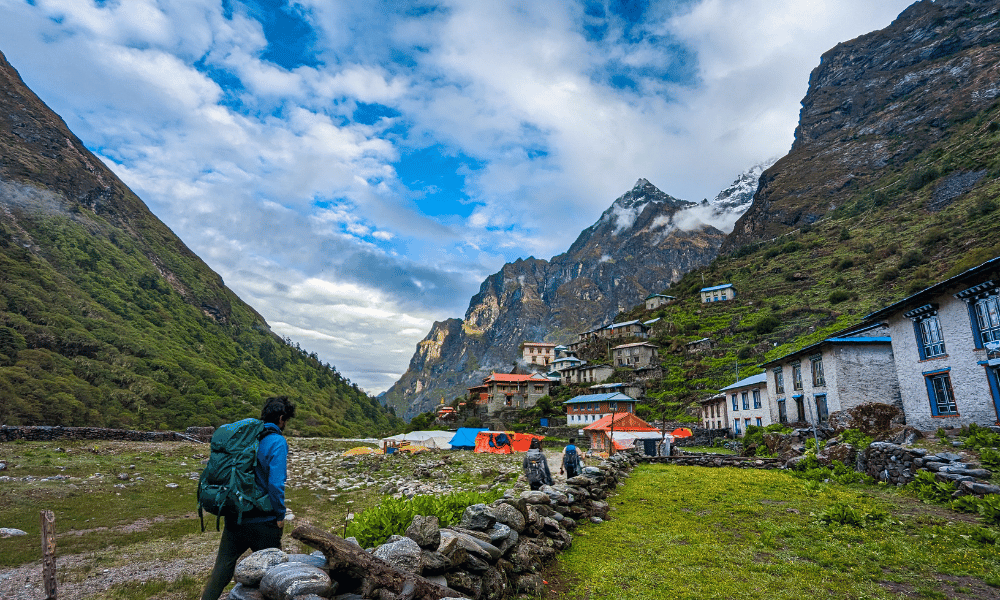
From Beding, proceed to Na Village, witnessing unique landscapes and traditional houses.
The trail offers stunning views, small waterfalls, and seasonal vegetation with vibrant flowers.
Upon reaching Na Village, soak in the beauty of the surrounding mountains and enjoy the peaceful ambiance.
Embark on a side trip to Tsho Rolpa Lake, located at an elevation of 4,580 meters.
Marvel at the grandeur of the lake, enclosed by towering mountains, and consider visiting Dudh Kunda, a smaller lake above Tsho Rolpa Lake.
Begin your return journey from Na Village, retracing your steps back to Dongang.
Enjoy the downhill trail, passing through forests, hamlets, and delightful waterfalls.
Interact with locals and immerse yourself in the natural beauty of the surroundings.
From Dongang, continue descending towards Chetchet, where you started your trek.
The trail offers panoramic views, small streams, and a refreshing bath option at a natural pool.
Arrive back at Chetchet, marking the end of your Tsho Rolpa Lake Trek.
Reflect on the incredible experiences and memories you've gathered along the journey.
Leave for Kathmandu.
Note that this trail description provides an overview of the Tsho Rolpa Lake Trek and the notable landmarks along the way. The actual duration and distances covered may vary depending on your pace, fitness level, and specific itinerary.
The trek is full of places and locations that will blow your mind with its raw beauty. The following trek highlights offer a glimpse into the extraordinary experiences that await you in the Tsho Rolpa Lake Trek. Let the magic of the Himalayas unfold before your eyes, creating memories that will last a lifetime.
Tsho Rolpa Lake is situated within Gaurishankar Conservation Area in Nepal’s Dolakha district. It is Nepal’s largest glacier lake, located at an altitude of 4,580 meters above sea level. The length spans 3.5 kilometers in length, covering an area of 1.6 kilometers with a maximum depth of 132 meters.
Reaching the lake requires navigating a challenging and steep trail, particularly windy afternoon. However, the effort is rewarded with a spectacular view of the valley and mountains above 7,000 meters, including Gaurishankar (7,145m) and Menlungtse (7,181m). Tsho Rolpa Lake's water level has steadily risen over the past five decades due to accelerated global warming.
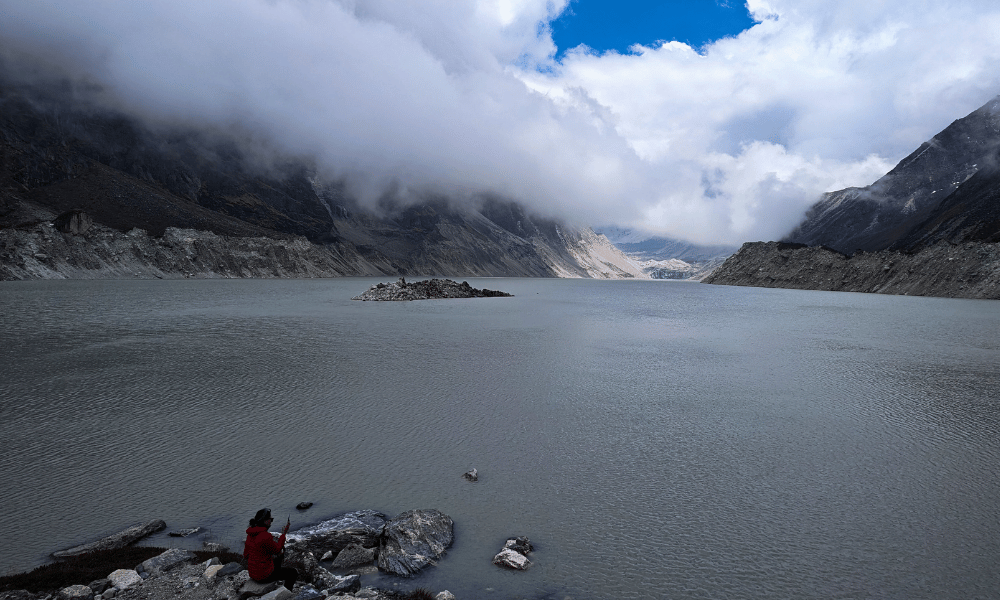
The lake's serene ambiance and natural beauty make it a popular destination for hikers. The stillness is occasionally broken by the sound of the wind, adding to the lake's allure. Warm clothing is recommended, especially as the wind intensifies afternoon. At the lake's summit, a teahouse awaits, providing a warm cup of tea and a chance to take in the breathtaking surroundings.
During winter, Tsho Rolpa Lake freezes completely, offering a frozen landscape that allows travelers and trekkers to walk over the lake and enjoy the surrounding view even more. The frozen lake adds another dimension to the experience, showcasing the ever-changing nature of this remarkable destination. The high-altitude location provides a unique perspective, with the lake reflecting the towering mountains and the crisp air invigorating the senses.
To begin the trek, one must travel along the Araniko Highway to Charikot and then proceed to Chetchet/Chhoyt Chhoyt. As you approach the valley, the river becomes clearer and the settlements become sparser. Leaving behind the hustle and bustle of the city, you enter a minimalistic and peaceful area. Within the valley, you are greeted with breathtaking panoramas and enchanting waterfalls, which are among the natural attractions that captivate visitors. The journey also encompasses hydropower stations, suspension bridges, lush green hills, and off-road trails, adding to the overall experience.
As you venture deeper into the valley, you are enveloped by verdant hills and snow-capped mountains. The trek begins at an altitude of 2,000m and gradually ascends to over 4,500m above sea level. Along the way, you pass through villages such as Simi Gaun, where you can witness the authentic village lifestyle. Dongang and Na villages offer mystical and captivating landscapes that are both entertaining and inspiring. The region is home to yaks and highland cattle, adding to the allure of the natural surroundings.
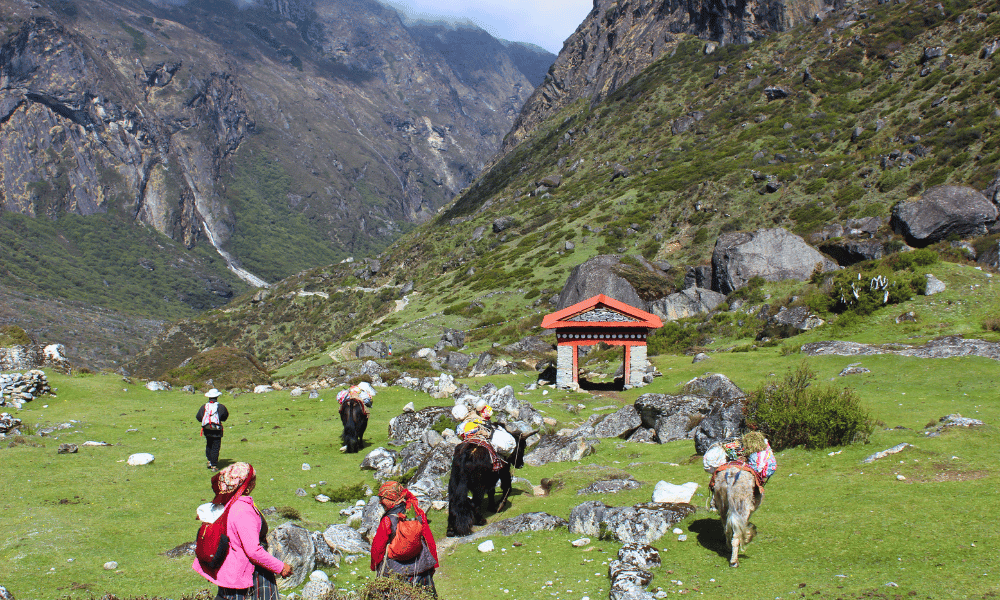
The local people in this area predominantly follow the Buddhist faith, evident from the large and vibrant murals on enormous rocks and the colorful prayer flags adorning the landscape. Stone carvings and unique architectural designs are also prominent features that showcase the rich cultural heritage of the region. As you venture into the highlands of Nepal, you are treated to views of mountains that leave visitors breathless. Dongang offers glimpses of Mt. Gaurishankar, and as you continue, you encounter other majestic peaks along the way.
The Rolwaling Valley in the Gaurishankar Conservation Area offers a captivating and authentic trekking experience. The majestic mountains, pristine natural landscapes, vibrant culture, and warm hospitality of the local people make it a truly memorable journey for those seeking adventure and tranquility in the heart of the Nepalese Himalayas.
Waterfalls are a prominent and captivating feature of the Tsho Rolpa Lake Trek, providing a remarkable highlight throughout the journey. From the beginning to the end of the trek, you will encounter stunning waterfalls in breathtaking locations.
During the drive to the trek's starting point, you will be treated to the sight of beautiful waterfalls in the distance, offering picturesque photo opportunities. As you trek, you will pass by smaller waterfalls where you can even enjoy a refreshing dive. The abundance of waterfalls is truly impressive, with one appearing approximately every kilometer or so. The sound of cascading water creates a peaceful and tranquil ambiance, allowing you to escape the hustle and bustle of city life and immerse yourself in the wild.
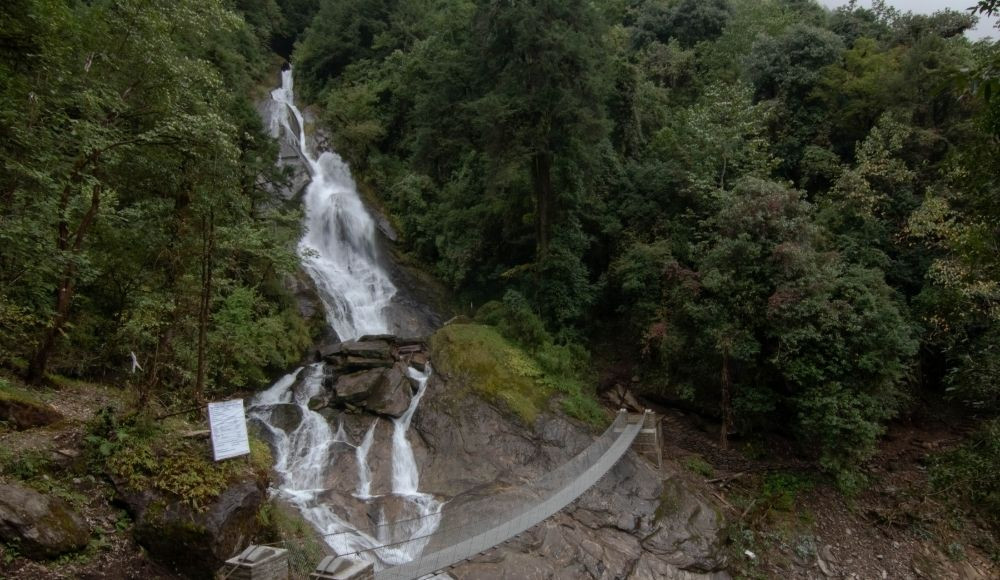
You'll be treated to a wonderful array of waterfalls, each with its own charm. Some of these waterfalls are conveniently located, allowing you to get up close and marvel at their splendor. Others, however, can be admired from a distance, adding a touch of mystery to the scenic landscape. As you make your way along the trekking path, you'll also come across sturdy suspension bridges that span across mighty rivers, providing a thrilling and enjoyable experience amidst the enchanting presence of these cascades.
To witness the waterfalls at their most magnificent, undertaking the trek during the monsoon season is highly recommended, as they swell with immense power and grandeur. If you have a fondness for waterfalls, this trek will undoubtedly captivate and inspire you. The trail is adorned with celestial waterfalls, where it seems as if the water is flowing directly from the heavens above.
Remember that the journey to Tsho Rolpa encompasses not only the magnificent lake itself but also the incredible sights and experiences that await you along the way. Prepare to be enchanted by the beauty of the waterfalls, embrace the serenity of nature, and cherish the unforgettable moments that await you on the Tsho Rolpa Lake trek.
The Gaurishankar Conservation Area serves as a vital link connecting two prominent national parks in Nepal, namely the Langtang National Park (LNP) and the Sagarmatha National Park (SNP). Recognized by the government as an official conservation area in 2010, it safeguards a diverse range of vegetation and wildlife that are not easily found in other parts of the country.
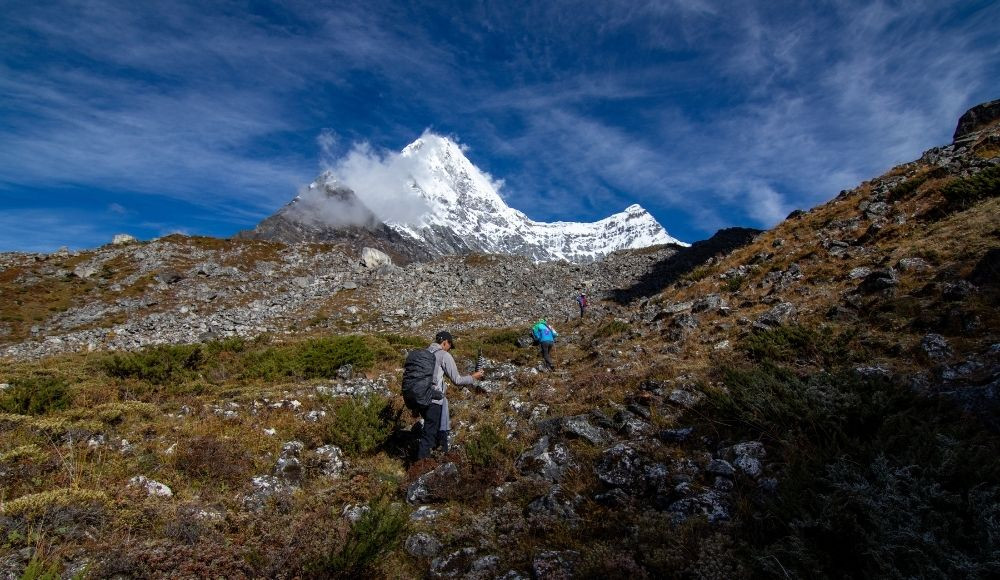
The area boasts an impressive collection of 16 major vegetation types, including Pinus Roxburgii, Schima Castanopsis, Alnus forest, Pinus Wallichiana forest, Pinus Patula forest, Rhododendron forest, Lower temperature Oak, Juniperus, moist alpine shrubs, and more. As you explore this verdant landscape, keep a keen eye out for some of the region's rare and captivating creatures, such as the Red Panda, Musk deer, Snow Leopard, Pangolin, Assamese monkey, Clouded leopard, and other majestic species.
Moreover, the Gaurishankar Conservation Area is a haven for avian enthusiasts, hosting a variety of exquisite bird species, including the enchanting Impeyan Pheasant and the resplendent Crimson Horned Pheasant, among other captivating winged creatures. As you embark on your journey through this remarkable terrain, be sure to immerse yourself in the captivating beauty of your surroundings, but also stay mindful of the path ahead to ensure you don't miss any of nature's delightful wonders that await you.
Setting foot on the captivating Tsho Rolpa Lake trek, you will have the chance to delve into the authentic mountain experiences offered by the villages and hamlets along the way. These charming settlements showcase the untamed beauty of the region, each possessing its own unique allure.
The journey commences with Simi Gaun, the largest settlement on the trek, nestled atop a hill at an altitude of 2000m. From this elevated position, you will be treated to awe-inspiring vistas of the surrounding hills, adorned with traditional homes and vibrant fields of seasonal vegetation. As you traverse through this village, you will be enveloped in the tranquil ambiance of lush green forests.
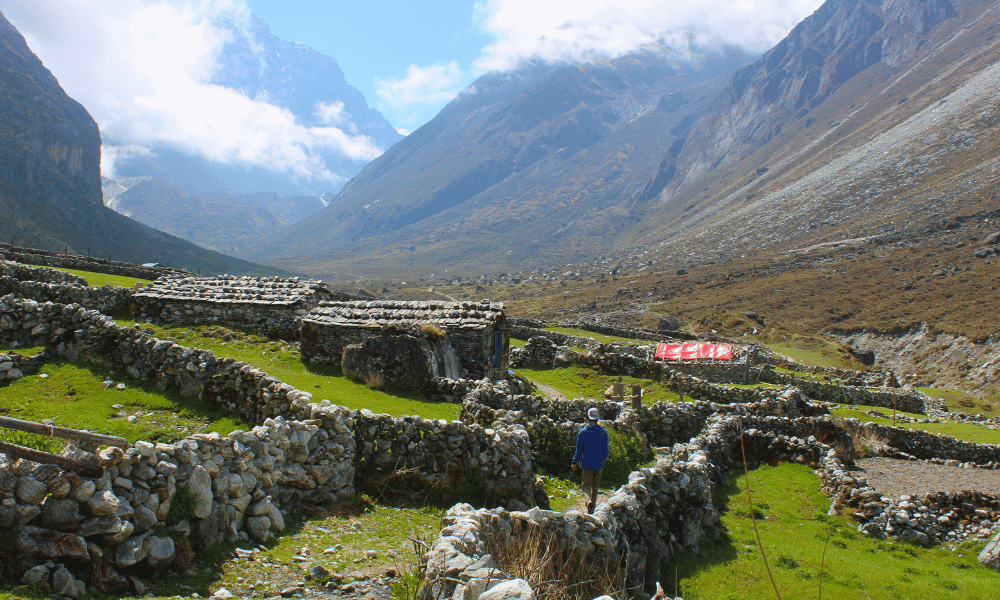
Continuing onward, the trek leads you further up the mountains, where the dense forest gradually gives way to sparse vegetation. Along the trail, the settlements become more scattered, offering limited lodging options at specific intervals. Dongang, a favored resting spot for trekkers, boasts a comfortable lodge nestled beside a flowing river, providing a serene retreat amidst nature's embrace.
Beding, the second-largest village along the route, holds its own charm. Here, you will find the last access to electricity throughout your journey. The village is home to a monastery, where over 300 monks dedicate themselves to the study of Buddhist doctrines. This spiritual sanctuary adds an air of tranquility and cultural significance to your trekking experience.
Finally, Na Village emerges as the last stop before reaching the pristine Tsho Rolpa Lake. The scenery here takes on a distinctive character, characterized by vast stretches of pastoral land where yaks and highland animals roam freely. Urban vegetation becomes scarce, allowing intricately carved stone sculptures and vibrant prayer flags to take center stage, showcasing the rich Buddhist culture of the area.
Depending on your trekking experience and expectations from the trek, you can either pick a relaxed 7 days trek or a more fast-paced 4-5 days trek. Below is a brief itinerary for both of these trips, pick as per your preference.
If you are a beginner trekker or looking for a more relaxed trip, enjoying the vistas along the way, this 7 day Tsho Rolpa Lake Trek from Kathmandu package will be perfect for you. Each day you will travel about 5-6 hours with enough breaks in between stops. Below is a brief breakdown of each day of your trek.
|
Day |
Activity/Night-Stay |
|
|
|
|
|
|
|
|
|
|
|
|
|
|
This itinerary is for those with advanced trekking experiences and high physical endurance. You will travel an average of 15 kilometers a day, in about 9-10 hours. This provides just as many vistas and fun experiences, just with less time to relax in between stops. If you are in a time-crunch, this is definitely the best option for you.
|
Day |
Activity/Night-Stay |
|
|
|
|
|
|
|
|
|
|
The Tsho Rolpa Lake trek offers breathtaking landscapes and mountain vistas throughout the year, but choosing the best time to visit can greatly enhance your experience. Each season brings its own unique charm and challenges, so let's explore the pros and cons of trekking in different seasons to help you decide when to embark on this unforgettable adventure.
Pros:
Mild Weather: Spring offers pleasant and mild weather, making it comfortable for trekking. The temperatures are not too hot or cold, making it ideal for daytime hiking and exploration.
Blooming Rhododendrons: This season is famous for the blooming of rhododendrons and various wildflowers. The forests come alive with vibrant colors, creating a picturesque and enchanting atmosphere.
Clear Views: The skies are relatively clear during spring, offering excellent mountain views and perfect opportunities for photography.
Longer Days: With longer daylight hours, you have more time for trekking and can cover longer distances.
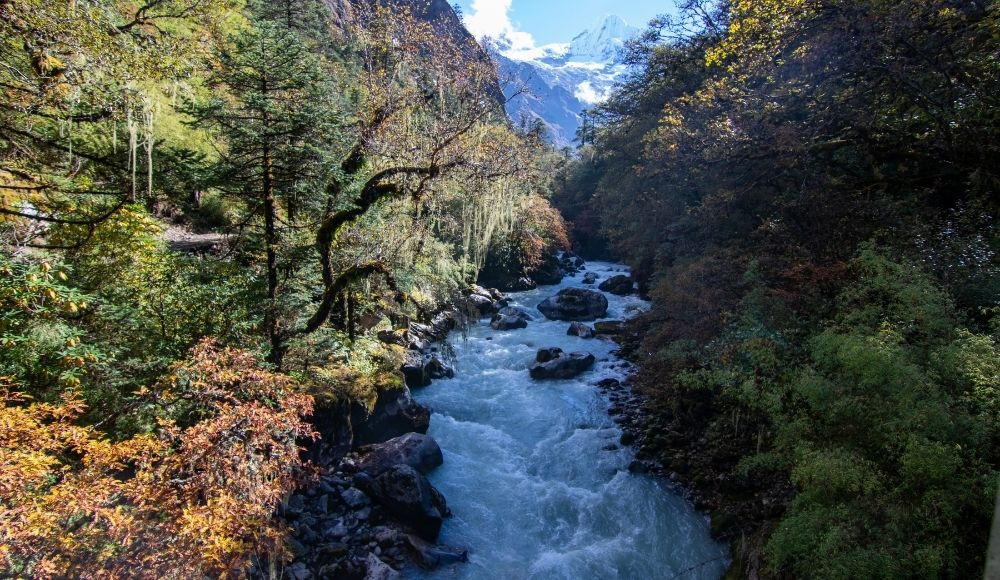
Cons:
Crowds: Spring is one of the popular trekking seasons in Nepal. As a result, the trails can get crowded, especially in popular trekking areas like the Tsho Rolpa Lake region.
Occasional Rain: Although it's generally a dry season, there might be occasional rain showers. It's essential to be prepared with rain gear and waterproof your belongings.
Snow at Higher Elevations: In the higher elevations, there might still be snow from the previous winter, which can make the trek more challenging and require proper equipment and experience.
Pros:
Lush Greenery: Summer is the monsoon season in Nepal, and the landscapes become lush and green. The countryside comes alive with blooming flowers and flourishing vegetation.
Fewer Crowds: Compared to the peak trekking seasons, you'll find fewer trekkers on the trails during summer, providing a more tranquil experience.
Cultural Exploration: This season offers an opportunity to experience unique cultural festivals and interact with locals during their vibrant festivities.
Cons:
Heavy Rainfall: Monsoon brings heavy rainfall, especially in July and August. The continuous rain can make the trails muddy and slippery, posing challenges for trekkers.
Limited Mountain Views: The clouds and mist during monsoon can obscure mountain views, which can be disappointing for those seeking clear vistas.
Leeches and Insects: The warm and wet conditions attract leeches and insects, which can be bothersome during the trek. It's essential to take precautions and wear appropriate clothing.

Pros:
Stable Weather: Autumn is widely regarded as the best time to trek in the Tsho Rolpa Lake region. The weather is stable, with clear skies and minimal rainfall, ensuring an enjoyable trekking experience.
Spectacular Mountain Views: The skies are crystal clear, providing unobstructed and breathtaking views of the surrounding mountains, including Gauri Shankar and Melungtse.
Festivals and Culture: You might have the chance to witness and partake in local festivals and cultural events as autumn is a vibrant time in Nepal.
Cons:
High Demand: Due to the favorable weather conditions, autumn attracts a large number of trekkers. It's advisable to make advance bookings for accommodations to secure a place in the tea houses and lodges.
Pros:
Tranquility: Winter offers a quieter and more peaceful trekking experience. The number of trekkers on the trail is significantly lower, providing a sense of solitude and connection with nature.
Clear Mountain Views: Winter skies are often clear, offering magnificent views of snow-capped peaks and stunning landscapes. The snow-covered trails create a serene and magical atmosphere.
Lower Elevation Trekking: Lower elevation regions during winter can have mild temperatures, allowing for comfortable trekking conditions.
Cons:
Cold Weather: Winter in the Tsho Rolpa Lake region can be extremely cold, especially at higher elevations. Temperatures can drop well below freezing, requiring proper winter clothing, insulation, and equipment.
Challenging Trekking Conditions: Higher elevations may experience heavy snowfall and icy trails, making the trek more challenging and potentially hazardous. It's crucial to have mountaineering experience and appropriate gear for winter trekking.
Limited Facilities: Some tea houses and lodges in remote areas may close during winter due to the low number of trekkers. It's essential to plan accordingly and ensure the availability of accommodations.
Consider your personal preferences, trekking experience, and tolerance for weather conditions when choosing the best time to visit the Tsho Rolpa Lake trek. It's also recommended to check weather forecasts, consult with local trekking agencies, and be well-prepared with the right gear for your chosen season.
When preparing for your Tsho Rolpa Lake trek, efficient packing is key to ensure you have all the necessary items while keeping your backpack light. Here's a guide to help you pack smartly and comfortably for your adventure:
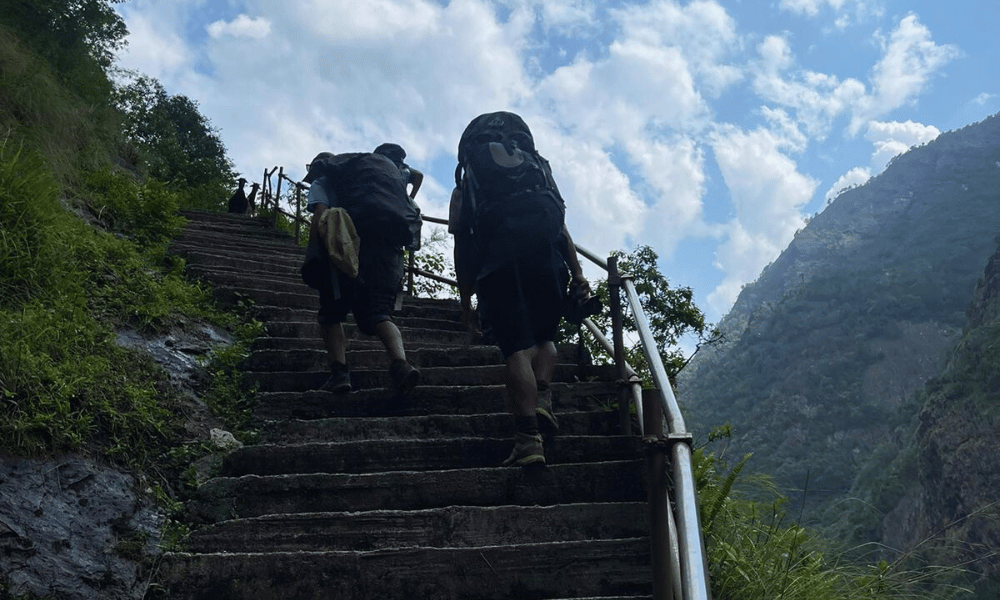
Clothing:
Choose moisture-wicking, quick-drying, and breathable hiking shirts and pants to stay comfortable during the trek.
Pack warm thermal layers such as long-sleeve shirts, pants, and fleece jackets to tackle colder temperatures.
Don't forget to bring a waterproof and windproof outer shell jacket to protect you from rain and strong winds.
Remember to pack hiking socks and liners to keep your feet dry and prevent blisters.
Select sturdy and comfortable hiking boots to provide proper support and grip.
Bring a hat or beanie for sun protection and warmth, and don't forget gloves for colder temperatures.
Trekking Gear:
Invest in a sturdy backpack with a rain cover to protect your belongings from wet weather.
Choose a sleeping bag suitable for cold weather conditions, rated below-freezing temperatures.
Consider using trekking poles for added stability and support during steep ascents and descents.
Additional Essentials:
Pack a headlamp or flashlight with extra batteries for navigating in low-light conditions.
Carry a reusable water bottle or hydration bladder to stay hydrated throughout the trek.
Include a first aid kit with essential medications, bandages, and blister care items.
Pack sunscreen, sunglasses, and a lip balm with SPF to protect your skin from the sun.
Include toiletries such as a travel-sized soap, toothbrush, and toilet paper.
Consider carrying a lightweight and quick-drying towel for personal hygiene.
Pack a variety of lightweight and nutritious snacks such as energy bars, trail mix, and dried fruits to keep you fueled during the trek.
By following this packing guide, including snacks and essential items, you'll be well-prepared for your Tsho Rolpa Lake trek. Remember to keep your backpack light and prioritize essential items while considering the weather and terrain conditions. Enjoy your adventure and make lasting memories in the beautiful Rolwaling region!
To ensure a safe, enjoyable, and culturally respectful journey, here are some essential dos and don'ts to keep in mind during your trekking experience.
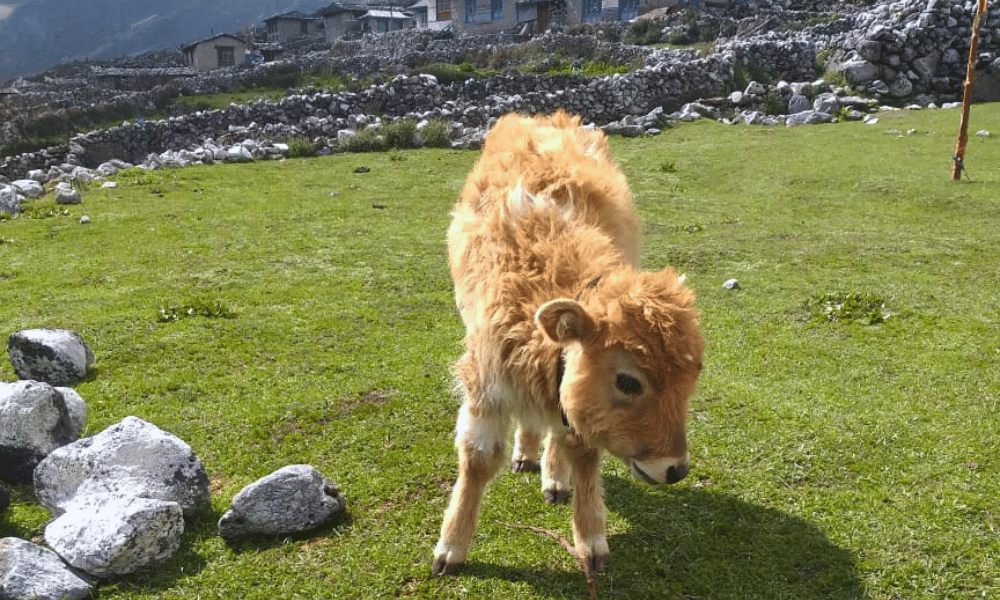
1. Select the ideal time to travel:
Remember to research and choose the best time to undertake the Tsho Rolpa Lake Trek, considering weather conditions and trail accessibility. The ideal time is generally during the spring (March to May) and autumn (September to November) seasons when the weather is pleasant, and the skies are clear, offering the best mountain views.
2. Choose a reputed trekking/travel organization:
Do select a reputable trekking or travel organization that offers experienced guides and ensures your safety throughout the journey. Look for organizations with positive reviews, certified guides, and a commitment to responsible and sustainable tourism practices.
3. Prepare and train for any situation:
Do undertake physical training and prepare yourself mentally for the challenges of trekking in high-altitude environments. Engage in cardiovascular exercises, hiking, and strength training to build stamina and endurance. Familiarize yourself with the potential risks and symptoms of altitude sickness and know how to respond in case of emergencies.
4. Pack efficiently with the Nepal trekking gear checklist:
Do pack your gear efficiently by referring to a comprehensive Nepal trekking gear checklist. Ensure you have all the necessary equipment for a comfortable and safe trek, including appropriate clothing layers, sturdy hiking boots, a backpack, a sleeping bag, trekking poles, and a first aid kit. Pack light but be prepared for changing weather conditions.
5. Carry all necessary paperwork:
Do carry all required travel documents, permits, and identification. Obtain the necessary trekking permits, such as the TIMS (Trekkers' Information Management System) card and the Sagarmatha National Park permit. Keep these documents safe and easily accessible. It's also advisable to have copies of important documents in electronic form.
6. Maintain body hydration at high elevations:
Do drink plenty of water and stay hydrated while trekking at high elevations. The dry mountain air and physical exertion can lead to dehydration, which may increase the risk of altitude sickness. Carry a reusable water bottle and regularly replenish your fluids by drinking safe, purified water or using water purification tablets.
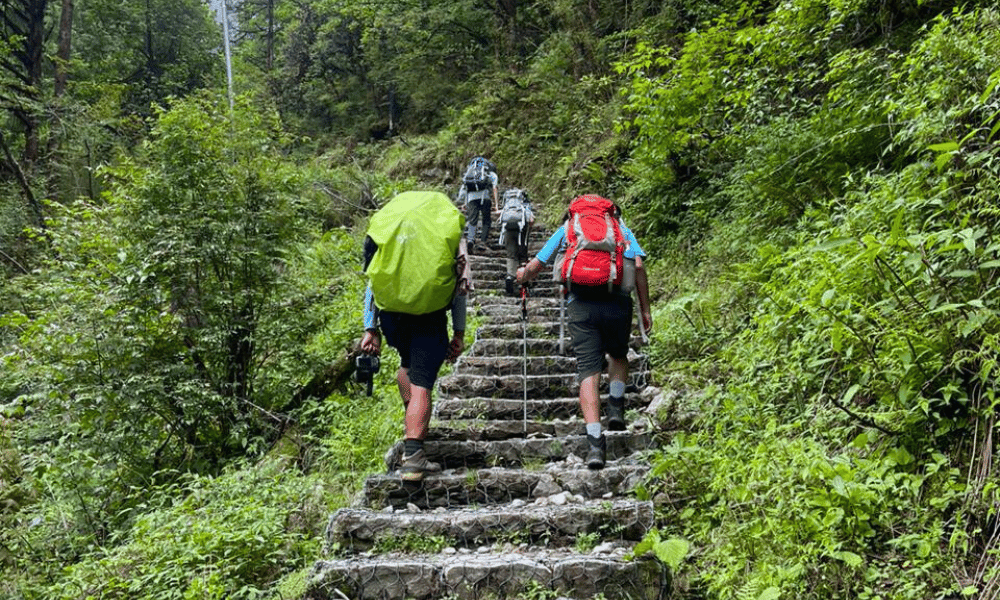
7. Have the proper personal gear:
Do invest in quality trekking gear that suits the terrain and climate. Dress in layers to adjust to changing temperatures. Wear moisture-wicking and breathable clothing to stay comfortable during the trek. Choose sturdy, well-fitting hiking boots to protect your feet and provide ankle support. Don't forget essentials like a hat, sunglasses, sunscreen, and a rain jacket
8. Respect the culture and people of the area:
Do respect the local culture, traditions, and customs. The Tsho Rolpa Lake Trek takes you through traditional villages inhabited by friendly locals. Learn about their customs, greet the locals with a smile, and be mindful of their way of life. Seek permission before entering religious sites or taking photographs of individuals.
9. Ask for permission before taking photos and videos:
Do seek permission before taking photos or videos of the locals. Respect their privacy and cultural norms. Engage in friendly interactions, show genuine interest in their stories, and seek their consent before capturing their images. Use photography as a means to connect and appreciate the local culture.
10. Travel for experience, not just for the sake of traveling:
Do embark on the Tsho Rolpa Lake Trek with the intention of immersing yourself in the experience. Embrace the natural beauty, challenge yourself physically and mentally, and create lasting memories. Interact with fellow trekkers, learn from your guides, and appreciate the journey as a transformative adventure.
11. Don't litter, put trash in its place:
Don't leave any waste behind. Practice responsible tourism by disposing of trash properly and leaving no trace of your presence. Carry a small garbage bag and pack out all non-biodegradable waste. Respect the pristine environment and help preserve it for future trekkers to enjoy.
In conclusion, embarking on the Tsho Rolpa Lake trek is a remarkable adventure that offers trekkers an opportunity to immerse themselves in the breathtaking landscapes of the Rolwaling region. This blog has provided valuable insights and tips to ensure a safe, enjoyable, and responsible trekking experience.
By selecting the ideal time to travel, trekkers can maximize their chances of favorable weather conditions and optimal visibility, enhancing their overall experience. Choosing a reputable trekking organization is essential as it provides experienced guides, reliable logistics, and a commitment to safety and responsible tourism.
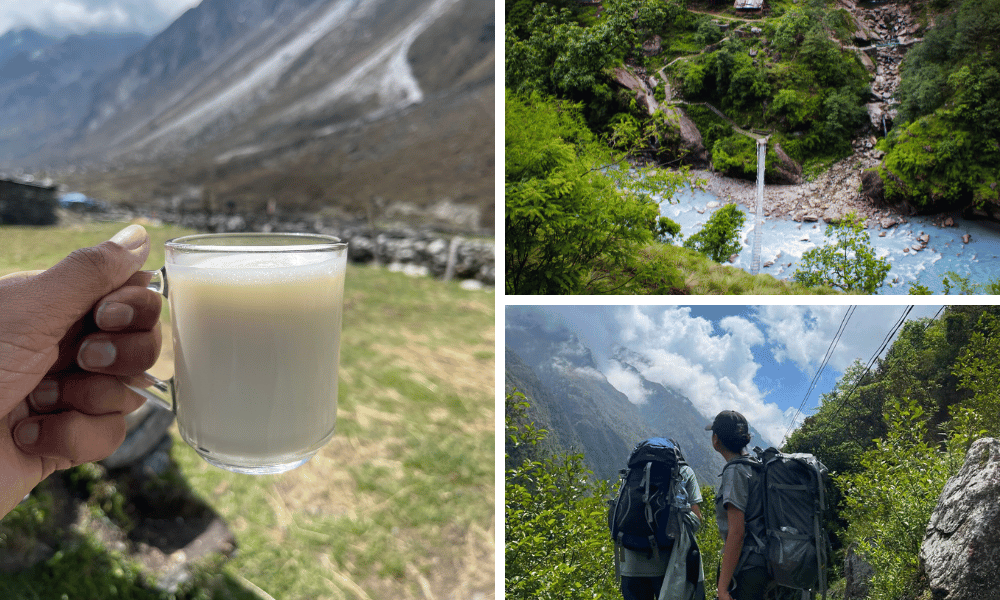
Preparing for the trek by undergoing physical training and equipping oneself with the necessary gear is crucial. From proper clothing and footwear to essential items like a first aid kit, trekkers should prioritize efficient packing to ensure comfort and safety throughout the journey.
Carrying all necessary paperwork, including permits and identification, is essential to comply with local regulations and enjoy a hassle-free trek. Furthermore, respecting the local culture and people is of utmost importance. Seeking permission before taking photos and videos, interacting with locals with kindness and curiosity, and being mindful of cultural practices contribute to a meaningful and respectful experience.
The Tsho Rolpa Lake trek is not just about ticking off a destination; it is about seeking personal growth, connecting with nature, and experiencing the world in a profound way. It is a journey that fosters a sense of adventure, self-discovery, and appreciation for the beauty that surrounds us.
Lastly, responsible travel practices are integral to preserving the natural wonders of the Rolwaling region. By following the principle of "leave no trace," trekkers can minimize their impact on the environment and ensure that future generations can also enjoy the pristine beauty of this remarkable landscape.
As you plan your Tsho Rolpa Lake trek, keep these tips and insights in mind to make the most of your adventure. Embrace the challenges, savor the breathtaking views, and let the spirit of exploration guide you on this extraordinary journey. May the memories and lessons learned during this trek inspire you to continue exploring, protecting our planet, and seeking meaningful experiences in every corner of the world. Happy trekking!
The best time to trek to Tsho Rolpa Lake is during the spring (March to May) and autumn (September to November) seasons. These months offer stable weather, clear skies, and favorable trekking conditions.
While the Tsho Rolpa Lake trek is considered relatively easy, some hiking or trekking experience is recommended. It involves ascending to higher elevations above 3,000m. Having basic knowledge of hiking and being physically fit will enhance your trekking experience.
The trek can be completed in approximately 6-7 days, including the arrival and departure from Kathmandu. This duration allows ample time to enjoy the scenic beauty and explore the surroundings.
Yes, there are teahouses and lodges available along the Tsho Rolpa Lake trekking route. These accommodations provide basic amenities such as warm beds, clean washrooms, and good food. However, it is recommended to carry your sleeping bag for added comfort.
Tsho Rolpa Lake is located at an altitude of 4,580 meters above sea level. Trekking to this altitude requires acclimatization and proper preparation to avoid altitude sickness.
Yes, you will need two permits for the Tsho Rolpa Lake trek: the Gaurishankar Conservation Area Permit (GCAP) and the TIMS (Trekkers' Information Management System) card. These permits can be obtained in Kathmandu before starting the trek.
The weather in the Rolwaling Valley can be unpredictable. It is recommended to be prepared for both sunny and cloudy conditions, with the possibility of rain or snowfall. Layered clothing is advisable to adjust to changing weather conditions.
Yes, for more experienced trekkers, it is possible to extend the trek and cross the challenging Tashi Lapcha Pass (5,750m/18,875ft), which connects the Rolwaling Valley to the Everest region. This extension requires proper planning, additional permits, and mountaineering experience.
Essential items to pack include trekking boots, warm clothing, waterproof jackets and pants, a sleeping bag, a hat, gloves, sunscreen, sunglasses, a water bottle, a first aid kit, and toiletries. It is advisable to pack light while ensuring you have all the necessary items for the trek.